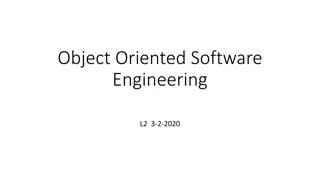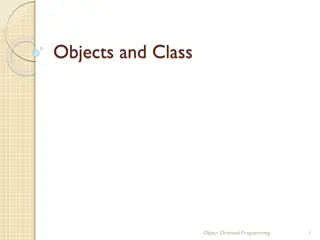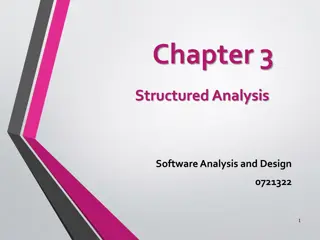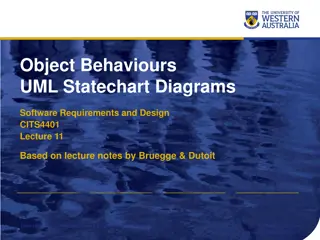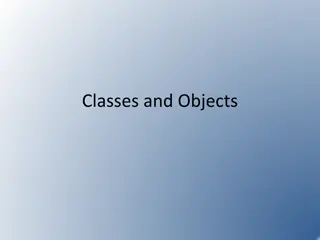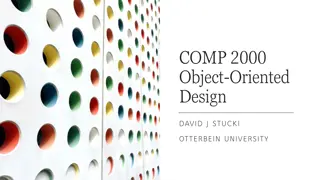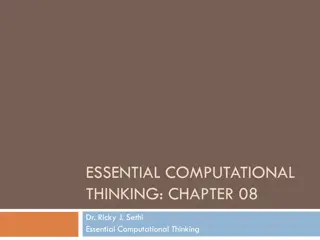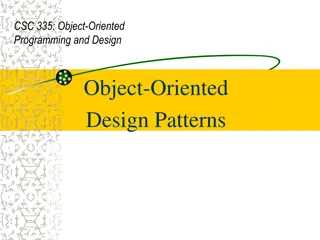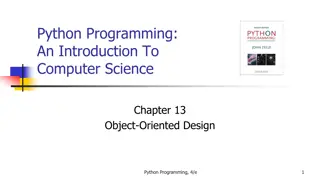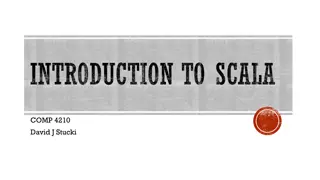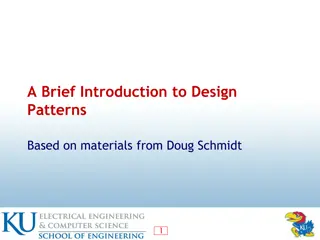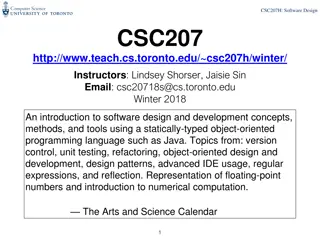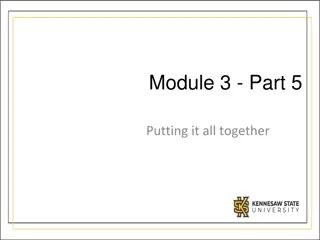Understanding Object-Oriented Analysis and Design (OOAD)
Object-oriented analysis and design (OOAD) is a software engineering approach that models systems as groups of interacting objects. OOAD involves analyzing, designing, and implementing software solutions based on objects and emphasizes logical solutions. It focuses on understanding and defining concepts in the problem domain for better communication and product quality.
Download Presentation

Please find below an Image/Link to download the presentation.
The content on the website is provided AS IS for your information and personal use only. It may not be sold, licensed, or shared on other websites without obtaining consent from the author. Download presentation by click this link. If you encounter any issues during the download, it is possible that the publisher has removed the file from their server.
E N D
Presentation Transcript
OBJECT ORIENTED ANALYSIS AND DESIGN Prepared by R. Gomathijayam Assistant Professor of CA Bon Secours College for Women
Object-oriented analysis and Design Object-oriented analysis and design (OOAD) is a popular technical approach for analyzing, designing an application, system, or business by applying the object oriented paradigm and visual modeling throughout the development life cycles for better communication and product quality. Object-oriented programming (OOP) is a method based on the concept of objects", which are data structures that contain data, in the form of fields, often known as attributes; and code, in the form of procedures, often known as methods.
Continued What is OOAD?- Object-oriented analysis and design (OOAD) is a software engineering approach that models a system as a group of interacting objects . Analysis understanding, finding and describing concepts inthe problem domain. Design understanding and defining software solution/objects that represent the analysis concepts and will eventually be implemented in code. OOAD - A software development approach that emphasizesa logical solution based on objects.
Continued Software development is dynamic and always undergoing major change. System development refers to all activities that go into producing information system solution. System development activities consist of system analysis, modelling, design, implementation, testing and maintenance. A software development methodology series of processes can lead to the development of an application. Practices, procedures, and rules used to develop software, totally based on system requirements
ORTHOGONALVIEWSOFTHESOFTWARE TwoApproaches, TraditionalApproach Objected-OrientedApproach TRADITIONALAPPROACH Collection of programs orfunctions. A system that is designed for performing certainactions. Algorithms + Data Structures =Programs. Software Development Models (Waterfall, Spiral, Incremental,etc..)
Continued OBJECT ORIENTEDAPPROACH OO development offers a different model from the traditional software based on functions and procedures. software is a collection of discrete object that encapsulate their dataas well as the functionality. Each object has attributes (properties) and method(procedures). software by building self contained modules or objects that can beeasily REPLACED, MODIFIED ANDREUSED. Objects grouped in to classes and object are responsible foritself.
BENEFITSOFOBJECTORIENTATION Faster development, Reusability, Increased quality modeling the real world and provides us with the stronger equivalence of the real world s entities (objects). Raising the level of abstraction to the point where application can be implemented in the same terms as they are described.
WHY OBJECTORIENTATION OO Methods enables to develop set of objects that work together software similar to traditional techniques. It adapts to Changing requirements Easier to maintain More robust Promote greater design Code reuse
Continued Others Higher level of abstraction Seamless transition among different phases of software development. Encouragement of good programming technique. Promotion of reusability.
OVERVIEWOFUNIFIEDAPPROACH The unified approach (UA) is a methodology for software development. Booch, Rumbaugh, Jacobson methodologies gives the best practices, processes and guidelines for OO oriented software development. Combines with the object management groups in unified modelling language. UA utilizes the unified modeling language (UML) which is a set of notations and conventions used to describe and model an application.
Continued LayeredArchitecture UA uses layered architecture to developapplications. Creates object that represent elements to the user through interface or physically stored in database. The layered approach consists of user interface, business, access layers. This approach reduces the interdependence of the user interface, database access and business control. More robust and flexible system.
OBJECTBASICS Goals: The developer should Define Objects and classes Describe objects, methods, attributes and how objects respond to messages, Define Polymorphism, Inheritance, data abstraction, encapsulation, and protocol, Describe objects relationships, Describe object persistence,
OBJECT ORIENTEDPHILOSOPHY The programming languages provide the programmers the way of describing the process. The ease of description, reusability, extensibility, readability, computational efficiency, and ability to maintain depends on languages used. System Software Machine Understandable language (Integers, floating point numbers, chars,Addressing Modes, .) Eg., Financial Investment Development of Financial Investment Machine directly would reduce translation.
Conti Object-Oriented Programming Concepts allows closer ideas and terms for the development of certain applications. Financial Investment : Bond (data type) character Buy operation on a bond (+) operation on a number
TRADITIONALAPPROACH The traditional approach to software development tends toward writing a lot of code to do all the things that have to be done. Algorithmic Centric Methodology only the algorithm that can accomplish the task. Data-Centric Methodology - think about the data to build a structure based on the algorithm You are the only active entity and the code is just basically a lot of building materials.
OBJECT-ORIENTEDAPPROACH OO approach is more like creating a lot of helpers take on an active role, a spirit, that form a community whose interactions become the application. Reusable Modified Replaced
EXAMPLESOFOBJECTORIENTEDSYSTEMS In OO system , everything is object . A spreadsheet cell, bar chart, title in bar chart, report, numbers, arrays, records, fields, files, forms, an invoice, etc. A window object is responsible for things like opening, sizing, and closing itself. A chart object is responsible for things like maintaining data and labels even for drawing itself.
WHATISANOBJECT? The term object was first formally utilized in the Simula language to simulate some aspect of reality. Attributes or properties describe object s state (data) and methods (properties or functions) define its behavior. An object is an entity. It knows things (has attributes) It does things (provides services or has methods Examples in next Slide .
OBJECTSATTRIBUTES Attributes represented by data type. They describe objects states. In the Car example the car s attributes are: color, manufacturer, cost, owner, model, etc.
OBJECTSMETHODS Methods define objects behaviour and specify the way in which an Object s data are manipulated. In the Car example the car s methods are: drive it, lock it, tow it, carry passenger in it.
IT KNOWS THINGS (ATTRIBUTES) I am an Employee. I know my name, social security numberand my address. Object-Oriented Systems Development Bahrami ? Irwin/ McGraw-Hill
ATTRIBUTES I am a Car. I know my color, manufacturer, cost, owner and model. Object-Oriented Systems Development Bahrami ? Irwin/ McGraw-Hill
IT DOES THINGS(METHODS) I know how to compute my payroll. Object-Oriented Systems Development Bahrami ? Irwin/ McGraw-Hill




